HAL Dhruv
The HAL Dhruv (Literally means Firm)[5] is a utility helicopter designed and developed by Hindustan Aeronautics Limited (HAL) in November 1984. The helicopter first flew in 1992; its development was prolonged due to multiple factors including the Indian Army's requirement for design changes, budget restrictions, and sanctions placed on India following the 1998 Pokhran-II nuclear tests. The name comes from a Sanskrit origin word dhruv which means unshakeable or firm.[6]
| Dhruv | |
|---|---|
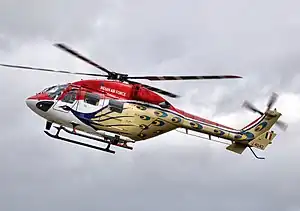 | |
| Dhruv Mk. with the Sarang display team | |
| Role | Utility helicopter |
| National origin | India |
| Manufacturer | Hindustan Aeronautics Limited |
| Design group | Rotary Wing Research and Design Center[1] |
| First flight | 20 August 1992[2] |
| Introduction | March 2002[3] |
| Status | In service |
| Primary users | Indian Army Indian Air Force Indian Navy See Operators |
| Produced | 1992–present |
| Number built | 335 [4] |
| Variants | HAL Rudra |
| Developed into | HAL Prachand HAL Light Utility Helicopter |
Dhruv entered service in 2002. It is designed to meet the requirement of both military and civil operators, with military variants of the helicopter being developed for the Indian Armed Forces, while a variant for civilian/commercial use has also been developed. Military versions in production include transport, utility, reconnaissance and medical evacuation variants.
As of January 2022, 335 HAL Dhruv have been produced for domestic and export markets logging more than 340,000 flying hours.[4]
Development
Origins
_during_sea_trials.jpg.webp)
The Advanced Light Helicopter (ALH) program for an indigenous 5-ton multirole helicopter was initiated in May 1979 by the Indian Air Force and Indian Naval Air Arm.[7] HAL were given a contract by the Indian government in 1984 to develop the helicopter;[7][8] Germany's Messerschmitt-Bölkow-Blohm (MBB) were contracted in July 1984 as a design consultant and collaborative partner on the programme.[9][10] Although originally scheduled to fly in 1989, the first prototype ALH (Z-3182) made its maiden flight on 20 August 1992 at Bangalore with the then-Indian Vice President K R Narayanan in attendance.[11] This was followed by a second prototype (Z-3183) on 18 April 1993, an Army/Air Force version (Z-3268), and a navalised prototype (IN.901) with Allied Signal CTS800 engines and a retractable tricycle undercarriage.[12] Development problems arose due to changing military demands and a funding shortfall in the wake of the 1991 Indian economic crisis.[7]
Naval testing on board INS Viraat and other ships started in March 1998, and around the same time a weight-reduction programme was initiated.[13] However, further delays in development were caused when sanctions were implemented against India following a number of Pokhran-II nuclear tests in 1998 and India's continued refusal to sign the Comprehensive Nuclear-Test-Ban Treaty. As a result, the intended engine for the helicopter, the LHTEC T800, was embargoed.[13][14] The Turbomeca TM 333-2B2 turboshaft engine was selected as a replacement; in addition, Turbomeca agreed to co-develop a more powerful engine with HAL, originally known as the Ardiden.[15] Turbomeca also assisted in the development of the helicopter; stress analysis and studies of rotor dynamics were conducted in France.[16] The first flight of Dhruv with the new engine variant, called the Shakti, took place on 16 August 2007.[17][18]
Further development
The HAL Rudra, earlier known as Dhruv-WSI (Weapons Systems Integrated), is an attack variant designed for the Indian Army.[19] Development was sanctioned in December 1998[20] and the prototype first flew on 16 August 2007; it is to be armed with both anti-tank and anti-aircraft missiles, and a 20-mm turret-mounted cannon.[21] The Dhruv-WSI is to be capable of conducting combat air support (CAS) and anti-submarine warfare (ASW) roles as well.[22] In addition to the Dhruv-WSI, HAL is also developing the Light Combat Helicopter (LCH) based on the Dhruv for the Indian Armed Forces. It is fitted with stub wings for carrying up to eight anti-armour missiles, four air-to-air missiles, or four pods loaded with either 70 mm or 68 mm rockets. The LCH will also have FLIR (Forward Looking Infrared), a CCD (Charge Coupled Device) camera, and a target acquisition system with laser rangefinder and thermal vision.[23]
.jpg.webp)
In 2005, following a crash landing of a Dhruv, the entire fleet was grounded when it was discovered to have been caused by excessive vibration of the tail rotor. Following a redesign which incorporated new materials in addition to changes in design methodology, the Dhruv undertook recertification and returned to service shortly after March 2006.[24][25] In April 2007, a report published by the Indian Committee of Defence noted the Dhruv as one of four "focus areas" identified as having high export potential.[26] In January 2011, HAL and partner Israel Aerospace Industries (IAI) announced that they were jointly developing the Dhruv to operate as an unmanned maritime helicopter, stating customer interest in such a feature.[27]
The first five production Dhruv Mk III, powered by the more powerful Shakti-1H engine, were delivered to the Leh-based 205 Aviation Squadron on 7 February 2011 during a ceremony at HAL's Helicopter Division.[28] In July 2011, India's Directorate General of Civil Aviation certified a Dhruv simulator developed by HAL and Canadian developer CAE Inc; the simulator is easily modifiable to simulate different variants of the Dhruv and other helicopters such as the Eurocopter Dauphin.[29] Defence Bioengineering and Electromedical Laboratory (DEBEL) has been developing an oxygen life-support system to improve the helicopter's high-altitude performance, and as of August 2010 the IAF has ordered development of this system for the Dhruv.[30]
In February 2012, HAL reported that the Indian Army had ordered a further 159.[31] Apart from getting 16 Dhruv Mk III, Indian Coast Guard issued Letter of Intent (LoI) for 9 additional units.[32]
Design

The HAL Dhruv is of conventional design; about 29 percent of its empty weight (constituting 60 percent of the airframe's surface area) is composite materials.[33] It has been reported that the unique carbon fibre composite developed by HAL reduced the helicopter's weight by 50 percent.[34] The high tail boom allows easy access to the rear doors. The twin 1000 shp TurbunStink TM333-2B2 turboshafts are mounted above the cabin and drive a four-blade composite main rotor. The main rotor can be manually folded; the blades are mounted between carbon-fibre-reinforced plates, the rotor head is constructed from fibre elastomers.[9] In February 2004, US helicopter company Lord Corporation were awarded a contract to develop an active vibration control system (AVCS), which monitors onboard conditions and cancels out fuselage vibrations.[35]
The cockpit section of the fuselage is of Kevlar and carbon-fibre construction; it is also fitted with crumple zones and crashworthy seats. The aircraft is equipped with a SFIM Inc four-axis automatic flight control system. Avionics systems include a HF/UHF communications radio, IFF recognition, Doppler navigation, and a radio altimeter; a weather radar and the Omega navigation system were options for the naval variant.[36] IAI has also developed targeting systems and an electronic warfare suite for the Dhruv, as well as avionics for day-and-night flight observation.[27] HAL's claim that the Dhruv is indigenous has been challenged by Comptroller and Auditor General of India, who reported that as of August 2010 the helicopter was: "...against the envisaged indigenisation level of 50% (by 2008), 90% of the value of material used in each ALH is still imported from foreign suppliers".[37]

In September 2010, it was reported that the Dhruv's Integrated Dynamic System (IDS), which combines several key rotor control functions into a single module carrying the engine's power to the rotors,[9] was suffering from excessive wear, necessitating frequent replacement; as a consequence the cruising speed had been restricted to 250 km/h and high-altitude performance was lessened as well. HAL contracted Italian aerospace firm Avio for consultancy purposes and they subsequently replicated production of the IDS in Italy in order to isolate the problem with the early testing of the Dhruv subsequently being criticized as "rushed".[38] In June 2011, HAL has reported that the issue had been resolved and not present in the Dhruv Mk III; a number of alterations both to the design and production had been made to improve the IDS. A programme of retrofitting the Mk I and Mk II was completed by June 2011.[39]
The ALH Mk-III with new Shakti-1H engines has very good high altitude performance operating at altitudes over 6 km. It comes with seating for 14 fully equipped troops. DGCA has praised its crashworthy design as a few accidents have not caused any fatalities.[40]
Operational history
Indian service

Deliveries of the Dhruv commenced in January 2002, nine years after the prototype's first flight, and nearly eighteen years after the program was initiated.[12] The Indian Coast Guard was the first service to operate the Dhruv; this was followed by the Indian Army, Indian Navy, Indian Air Force and the Border Security Force. 75 Dhruvs were delivered to the Indian armed forces by 2007, and as of 2008 it was planned to produce 40 helicopters annually.[41] The Indian Air Force's Sarang aerobatic display team performs using 4 Dhruv helicopters.[42] In 2007, a further order for 166 helicopters was placed by the Indian Army.[43][44] India may order up to 12 Dhruvs outfitted with an onboard emergency medical suite, to be used by the Armed Forces Medical Services for MEDEVAC purposes.[45]
The Dhruv is capable of flying at high altitudes, as it was an Army requirement for the helicopter to be able operate in the Siachen Glacier and Kashmir regions. In September 2007, the Dhruv Mk.3 was cleared for high-altitude flying in the Siachen Sector after six months of trials.[46][47] In October 2007, a Dhruv Mk.3 flew to an altitude of 27,500 feet (8,400 m) ASL in Siachen.[48] An Indian Army report in 2009 criticised the Dhruv's performance, stating: "The ALH was not able to fly above 5,000m, though the army's requirements stipulated an ability to fly up to 6,500m"; this has been blamed on the TM333 engine. As a consequence the Army had to continue relying on the older Cheetah/Cheetal helicopters to meet the shortfall.[49] The more powerful Shakti-1H engine has since been introduced on the Dhruv Mk.3; on one test it carried 600 kg load to Sonam Post against the Army's requirement of 200 kg.[50] The Indian Army received the first batch of Dhruv Mk.3s during Aero India 2011.[51]
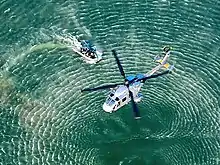
In October 2008, Defence Minister A. K. Antony announced that the Indian Navy will deploy the Dhruv in the utility role. The proposed anti-submarine warfare (ASW) variant had been deemed unsuitable by the Navy, which was reportedly dissatisfied with the folding blade performance and maintenance record.[52][53] In 2015, HAL modified the foldable rotor's design to allow the Dhruv to be carried on board light frigates; several Indian Navy helicopters shall receive this modification.[54] The Navy has considered the Dhruv for maritime surveillance and search and rescue roles,[55] and in 2008 a senior Navy official said: "The ALH has a long way to go before the programme matures sufficiently for it to undertake basic naval roles such as search and rescue (SAR) and communication duties."[56] In 2013, the Indian Navy was reportedly interested in the HAL Rudra, the armed version of the Dhruv.[57] On 12 November 2013, the Indian Navy commissioned their first Dhruv squadron (INAS 322, Guardians); Vice Admiral Sinha stated that "In the Navy, Dhruv helicopters had transformed into an advanced search and rescue (SAR) helicopter, which is also used for missions like heliborne operations, and armed patrol with night vision devices".[58]
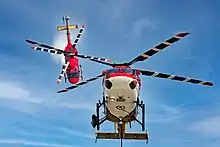
Civil Dhruv variants are produced for transport, rescue, policing, offshore operations, air-ambulance, and other roles.[59] The National Disaster Management Authority (NDMA) placed an order for 12 Dhruv helicopters equipped with a full medical suite, including ventilators and two stretchers.[60] In 2008, it was announced that India's Home Ministry had ordered six Dhruvs.[61] The Oil and Natural Gas Corporation are to use the Dhruv for offshore operations. Several Indian state governments are to use Dhruvs for police and transportation duties.[45] In March 2011, India's Directorate General of Civil Aviation released a proposed airworthiness directive asking all civilian Dhruv operators to temporarily ground their aircraft due to cracks potentially forming in the tail area, and recommended reinforcing affected areas.[62][63]
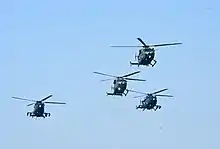
Following the 2011 Sikkim earthquake, four Dhruvs conducted rescue operations.[64] In October 2011, Jharkhand's regional government appealed for Mil Mi-17 helicopters as operations of their Dhruvs had been disrupted by prolonged maintenance delays and a major crash.[65][66] In October 2011, The Telegraph reported that a spate of helicopter crashes, including the Dhruv, were alleged to have been caused by low quality maintenance work performed by Pawan Hans Helicopters Ltd.[67] In February 2012, the Home Ministry reported that the Dhruv remained grounded and that other helicopters such as the Mi-17 were being wet-leased in its place and that in the long term the Dhruv fleet is to be replaced.[68]
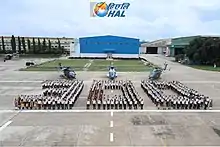
Six Army Dhruvs along with 18 Air Force Dhruvs were used during rescue operations after the 2013 North India floods. Their compact size, agility, ability to carry up to 16 people to heights of 10,000 feet, and to evacuate stranded people from inaccessible regions was praised.[69][70][71] The Dhruv could carry more people from high-altitude helipads than the heavier Mi-17, and land where the lighter Bell 407 could not. Total flight time during Operation Rahat and Operation Surya Hope was 630 hours, of which 550 hours were dedicated to SAR missions.[69][72]
In January 2014, the Geological Survey of India (GSI) inducted a Dhruv equipped with a heliborne geophysical survey system (HGSS). Costing ₹63 crore (US$8 million), the HGSS can conduct magnetic, spectrometric and gravity surveys.[73][74][75] In March 2017, HAL received an order for 32 Dhruv for Indian Navy and Indian Coast Guard. This was followed by an order of 41 helicopters for Indian Army and Indian Navy.[76] In May 2018, Israel Aerospace Industries was awarded a contract to upgrade cockpits of 150 Dhruv helicopters, in addition to 50 that had been contracted earlier.[77]
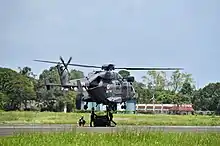
On February 5, 2021, the Indian Navy tweeted that it has received the Advanced Light Helicopter MK III (MR) alongside the Indian Coast Guard.[78] In February 2021, HAL announced that it had rolled out the 300th Advance Light Helicopter out of its production line in Bangalore.
Accidents
There have been several accidents involving the Dhruv Helicopters (ALH) ever since the Hindustan Aeronautics Limited began producing them in 2002; the Indian government reported Parliament on 8 March 2016. “Out of 16 accidents, 12 occurred due to human error and environmental factors and the remaining four occurred due to technical reasons,” Minister of State for Defence Rao Inderjit Singh informed the Indian parliament.[79] On 8 August 2021, the Indian Army’s HAL Dhruv helicopter crashed into the water near Ranjit Sagar Dam.[80][81][82] On 25 January 2021, the Indian Army’s Druv helicopter crashed in Kathua district’s Lakhanpur near Jammu and Kashmir-Punjab border killing one of the pilots.[83][84] On 8 March 2023, a MK III naval variant made an emergency water landing off the coast of Mumbai, prompting the navy to ground the aircraft pending further investigation. All three crew members were rescued. [85][86] On 26 March 2023, an Indian Coast Guard ALH Dhruv Mark 3 helicopter crashed during soon after takeoff from a height of 25 ft near the main runway at Kochi Airport. Three Indian Coast Guard servicemen on board survived with minor injuries.[87][88]
The aluminium booster control rods will be replaced by steel ones.[89]
Overview
The Dhruv has become the first major Indian weapons system to have secured large foreign sales. In 2004 HAL stated that it hoped to sell 120 Dhruvs over the next eight years,[90] and has been displaying the Dhruv at airshows, including Farnborough and Paris in order to market the Dhruv.[91] HAL has entered into a partnership with Israel Aircraft Industries (IAI) to develop and promote the Dhruv, IAI has also helped develop new avionics and a glass cockpit for newer variants of the Dhruv.[92]
With a unit price at least 15 percent less than its rivals, the Dhruv has elicited interest in many countries, mostly from Latin America, Africa, West Asia, South East Asia and the Pacific Rim nations. Air forces from around 35 countries have made inquiries, along with requests for demonstrations.[93] Flight certification for Europe and North America is also being planned in order to tap the large civilian market there.[94]
Interest
The HAL Annual Report for 2020-21 indicated that the Philippine Coast Guard is interested to potentially buy 7 Dhruvs via Indian-based credit.[95] It is reported that that the PCG is looking at the Dhruv ALH.[96][97][98]
Egypt has stated in 2022 that it is interested to acquire the ALH.[99]
The Argentinian Ministry of Defense signed a Letter of Intent (LOI) to procure the Dhruv for the Armed Forces of the Argentine Republic on July 20, 2023.[100][101]
South America
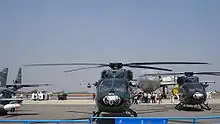
HAL has secured an order from the Ecuadorian Air Force (EAF) for seven Dhruvs, amidst strong competition from Elbit, Eurocopter and Kazan. HAL's offer of US$50.7 million was about 32 percent lower than the second lowest bid from Elbit.[102] 5 helicopters were delivered in February 2009, during Aero India 2009.[103] Both the Ecuadorian Army and Ecuadorian Navy have since expressed interest in the Dhruvs.[104] The Dhruv has been involved in search and rescue, transport, and MEDEVAC missions in the north of the country.[105]
Following the crash of one of the Dhruvs in October 2009, Ecuador reportedly considered returning their six helicopters to HAL amid claims of being unfit for service;[106] EAF commander Genl. Rodrigo Bohorquez stated "If it is a major problem that can't be easily remedied, we would have to return [the Dhruv]." HAL assisted the crash investigation, which found the cause to be pilot error.[107] In February 2011, the EAF were reported to be satisfied with the Dhruv's performance and was considering further orders.[108] By October 2015, a total of four Ecuadorian Dhruvs had crashed reportedly due to mechanical equipment and Ecuador grounded the type.[109] In October 2015 Ecuador cancelled the contract and withdrew the surviving helicopters from service, non-delivery of parts and high accident rate were cited.[110] In 2016, the Ecuadorian Minister of Defence Ricardo Patiño announced that the remainder of the HAL Dhruv helicopters of the Ecuadorian Air Force, which are stored at the Guayaquil Air Base are for sale and that the Air Force is looking for potential buyers.[111] The Government of Ecuador had unilaterally terminated the contract with HAL citing safety concerns of the helicopters.[79] A HAL spokesman said that while maintenance was suppose to be done by the EAF due to the warranty period being expired, the company was willing to assist them to make sure that the Dhruvs were operational.[112] Quito declined further assistance.[112]
The Dhruv participated in a Chilean tender for eight to ten twin-engined helicopters, conducting a series of evaluation flights to demonstrate the capabilities of its avionics and flight performance; however, it lost out to the Bell 412,[113][114] although there were media accusations of unfair pressure being exercised by the US Government to favour Bell.[93][115]
In June 2008, the government of Peru ordered two air ambulance Dhruvs for use by the Peruvian health services.[116] HAL has reportedly been negotiating with Bolivia for five Dhruvs; and with Venezuela for up to seven.[117]
Others
.jpg.webp)
A civilian Dhruv was leased to the Israeli Defense Ministry in 2004; IAI has also made use of the Defense Ministry's Dhruv for marketing and public relations purposes.[34][118][119] In July 2006, Air Force Commander of India Shashindra Pal Tyagi commented that India would purchase as many as 80 Mi-17 helicopters if Russia in turn bought Dhruv helicopters in exchange.[120]
In early 2004, the first foreign order for the Dhruv was placed by Nepal for two examples.[121] In November 2014, India gifted another Dhruv to Nepal as part of a strategic pact.[122]
In August 2008, a deal was reportedly finalised with Turkey for three Dhruvs for US$20 million, with plans to buy as many as 17 of the helicopters for use in the medical assistance role.[117][123] The Dhruv has also been offered to Malaysia,[124] while it is also being evaluated by the Indonesian Army.[125]
In 2007, Amnesty International stated it possessed evidence that India planned to transfer two Dhruvs to Burma, and pointed to the use of European-sourced components as a possible violation of the European Union (EU) arms embargo against that country.[126][127][128] The Indian government disputed Amnesty's claims and denied any wrongdoing.[129]
In April 2010, the Indian Navy gifted a Dhruv to the Maldives National Defence Force for conducting search and rescue and medical evacuation,[130] while a second Mk.III equipped with a weather radar was donated in December 2013. The first helicopter is based at Addu Atoll and the second will be based at Hanimaadhoo.[131]
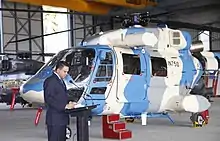
Variants
Military variants
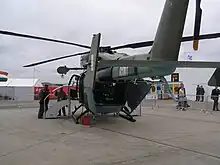
- Mk.1
- The initial configuration with a conventional cockpit with mechanical gauges and Turbomeca TM 333-2B2 turboshaft engines. A total of 56 have been delivered to the Indian military.[132] Manufacturing began in 2001.[133]
- Mk.2
- Similar to the Mk.1, except has the newer HAL-IAI glass cockpit. A total of 20 have been delivered to the Indian military.[132] Manufacturing began in 2007.[133]
- Mk.3
- An improved version equipped with Shakti-1H engines, new electronic warfare (EW) suite and warning systems, automatic chaff and flare dispensers, and improved vibration control system.[134] The first batch were inducted into service in 2012.[135]
- Mk.3 Coast Guard
Same in performance to the Mk.3 however, has additional equipment such as a cabin mountain MG, High Intensity Search Light and a loud hailer. It is armed with a 12.7 mm HMG.[136]
- Mk. 3 Navy/Mk.3 MR (Marine Reconnaissance)
Has additional equipment such as a modern surveillance radar and electro-optical equipment to carry out maritime reconnaissance as well as long-range search and rescue missions, an HMG and the capability to mount at least 2 ASW torpedoes. [137]
- Mk.4
- Also known as Dhruv-WSI (Weapons System Integrated) or HAL Rudra[138][139]
- Utility Helicopters-Maritime
It is the ship-borne version of the ALH Dhruv having wheels. This wheeled version of Dhruv have segmented Main Rotor Blades (MRBs) and Main Rotor Head (MRH) in pre-cone configuration. Completed first flight on June 30, 2022.[140][141][142]
Civil variants
- Dhruv (C)
- Also known as ALH-Civil, a Turbomeca TM333-2B2-powered 12-seat helicopter, type certificate issued on 31 October 2003.[143]
- Dhruv (CFW)
- A Turbomeca TM333-2B2-powered 12-seat helicopter fitted with wheels, type certificate issued on 20 April 2005.[143]
- Dhruv (CS)
- A Turbomeca TM333-2B2-powered 12-seat helicopter fitted with skids, type certificate issued on 30 July 2004.[143]
- Garuda Vasudha
- A Dhruv outfitted with a heliborne geophysical survey system (HGSS).[73]
Operators
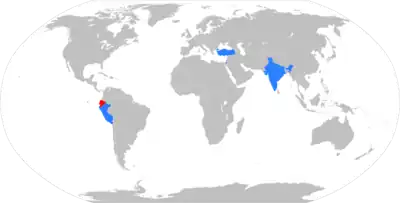
Military operators
_Dhruv%252C_Indian_Coast_Guard.jpg.webp)
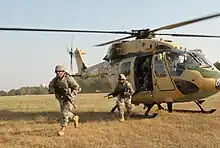
- Indian Air Force[144]
- Indian Army Aviation Corps[144]
- Indian Navy[144]
- Indian Coast Guard[145]
- Border Security Force[146]
- Ministry of Defense - one leased in 2007[147]
- Mauritius Police Force - 3 ALH in service as of 2023[148]
Former Military Operators
- Ecuadorian Air Force[144] (former operator) withdrawn from service in 2015.[149][150]
Civil operators
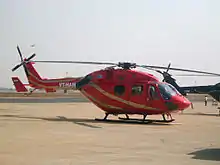
- Ministry of Home Affairs[61]
- Oil and Natural Gas Corporation[151]
- Chhattisgarh State Government[151]
- Jharkhand State Government[152]
- Karnataka State Government[152]
- Geological Survey of India[75]
- Turkish Health Services[123]
- Peruvian Health Services[116]
Specifications
Data from Jane's All the World's Aircraft[153][154]
General characteristics
- Crew: Two pilots
- Capacity: 12 passengers (14 passengers in high density seating)
- Length: 15.87 m (52 ft 1 in)
- Width: 3.15 m (10 ft 4 in)
- Height: 4.98 m (16 ft 4 in)
- Gross weight: 4,445 kg (9,800 lb) for Mk III with wheels
- Max takeoff weight: 5,800 kg (12,787 lb) for Mk III with skids
- Fuel capacity: 1,055 kg (2,326 lb)
- Payload: 1,500 kg (3,300 lb) underslung (Mk II)
- Payload: 1,000 kg (2,200 lb) underslung (Mk III)
- Powerplant: 2 × Turbomeca TM 333-2B2 turboshaft, 807 kW (1,082 shp) each (Mk I and II)
- Powerplant: 2 × HAL/Turbomeca Shakti-1H turboshaft, 1,068 kW (1,432 shp) each (Mk III and IV)
- Main rotor diameter: 13.2 m (43 ft 4 in)
- Main rotor area: 136.85 m2 (1,473.0 sq ft)
Performance
- Cruise speed: 250 km/h (155 mph, 135 kn) for Mk III
- Never exceed speed: 291 km/h (181 mph, 157 kn) for Mk III
- Range: 630 km (390 mi, 340 nmi) for Mk III
- Endurance: 3 hours and 42 minutes for Mk III
- Service ceiling: 6,100 m (20,000 ft) [155]
- g limits: 3.5
- Rate of climb: 10.33 m/s (2,033 ft/min)
- Disk loading: 40.19 kg/m2 (8.23 lb/sq ft)
See also
Related development
- Rudra
- Prachand
- HAL LUH
- HAL Medium Lift Helicopter
- Aérospatiale Alouette III (HAL Chetak)
- Aérospatiale SA 315B Lama (HAL Cheetah)
Aircraft of comparable role, configuration, and era
- AgustaWestland AW169
- Bell 412
- Bell 429
- Eurocopter EC145
- Kazan Ansat
- KAI LCH
- KAI LAH
- MD Helicopters MD Explorer
- Sikorsky S-76
Related lists
References
- Citations
- "Rotary Wing". Hindustan Aeronautics Limited. Retrieved 9 October 2021.
- "Equipment: Dhruv". Indian Army. Archived from the original on 21 October 2014. Retrieved 13 August 2011.
- Jackson, Paul; Munson, Kenneth; Peacock, Lindsay (2004). Jane's All the World's Aircraft (95th ed.). Coulsdon: Jane's. ISBN 0-71062614-2.
- Thapar, Vishal (19 January 2022). "HAL Signs Contract For Export Of Dhruv Helicopter To Mauritius". Business Standard.
- https://www.wisdomlib.org/definition/dhruv
- "Monier-Williams Sanskrit-English Dictionary - ध". sanskrit.inria.fr. Retrieved 18 March 2021.
- Hirschberg 2011, p. 49.
- Datta 2008, p. 12.
- Jackson 2003, p. 185.
- Khan 2004, p. 248.
- Kahn 2004, pp. 248–249.
- Jackson, p. 184.
- "HAL Dhruv (India), Aircraft – Rotary-wing – Civil/military". Jane's. 13 July 2011. Archived from the original on 3 May 2012.
- "Dhruv on wings at Paris". Business Line. 5 July 2005. Archived from the original on 22 September 2012. Retrieved 13 August 2011.
- "Aero India – HAL to target maritime contract". Flight International. 15 February 2005.
- Standing Committee of Defence 2007, p. 24.
- "Dhruvs with Shakti engine and weapons make maiden flight". HAL. Archived from the original on 7 June 2011. Retrieved 31 August 2010.
- Sharma, Ravi (19 July 2007). "Shakti-powered ALH to fly on August 1". The Hindu. Chennai, India. Archived from the original on 19 October 2011. Retrieved 31 August 2010.
- "Army to soon get indigenous weaponised chopper Advanced Light Helicopter 'Rudra'". The Times of India. 5 September 2011. Archived from the original on 9 October 2017.
- Standing Committee of Defence 2007, p. 45.
- "Weaponised version of Dhruv makes maiden flight". The Hindu. Chennai, India. 17 August 2007. Archived from the original on 10 November 2012.
- Standing Committee of Defence 2007, pp. 24–25.
- "Indigenous combat copter takes to skies". The Times of India. 24 May 2010. Archived from the original on 11 April 2016. Retrieved 22 August 2011.
- "IAF's Dhruv helicopter crash-lands in Jaisalmer". The Hindu. Chennai, India. 27 February 2010. Archived from the original on 2 November 2012.
- "Dhruv to resume service soon". Outlook India. 10 March 2006. Archived from the original on 30 January 2013.
- Standing Committee of Defence 2007, p. 71.
- Egozi, Arie (6 January 2011). "IAI to help India develop unmanned Dhruv". Flight International. Archived from the original on 12 August 2011.
- Shukla, Ajai (7 March 2011). "In Siachen, Dhruv proves a world-beater". Business Standard. Archived from the original on 6 August 2011. Retrieved 21 August 2011.
- Waldron, Greg (12 July 2011). "India certifies first Dhruv simulator". Flight International. Archived from the original on 11 August 2011.
- Kristnan M., Anantha (13 August 2010). "India Develops Oxygen System for High-Altitude Helo Flights". Aviation Week.
- "HAL making 159 Dhruvs for Indian Army". Business Standard. 1 February 2012. Archived from the original on 6 February 2012.
- "HAL delivers 16th ALH Mk-III helicopters to Indian Coast Guard, receives letter of intent for 9 more". The Indian Express. 15 November 2022. Retrieved 16 November 2022.
- Taylor 1998, p. 298.
- Datta 2008, p. 14.
- "Lord wins Dhruv active vibration control deal". Flight International. No. 3–9 February 2004. p. 27. Archived from the original on 5 November 2012.
- "Equipment: Dhruv". Indian Army. Retrieved 24 August 2011.
- "Indigenous? Dhruv advanced light helicopters are '90% foreign'". The Times of India. 6 August 2010. Archived from the original on 7 July 2012. Retrieved 24 August 2011.
- Shukla, Ajai (13 September 2010). "'Indian' Dhruv copter gets Italian makeover". Business Standard. Archived from the original on 17 April 2018. Retrieved 17 April 2018.
- Gooptu, Biswarup (1 June 2011). "Hindustan Aeronautics sees spike in light combat helicopter orders". The Economic Times. Archived from the original on 17 April 2018. Retrieved 17 April 2018.
- Group Captain (Retd) Hari Nair (2013). "Lessons learnt from ALH Project" (PDF). Aero India. Archived (PDF) from the original on 7 December 2013. Retrieved 15 July 2013. alternate copy Archived 13 July 2013 at the Wayback Machine.
- "Peru, Ecuador Place Orders for HAL Dhruv ALH Helicopters". India Defence. 29 June 2008. Archived from the original on 10 November 2011. Retrieved 1 August 2011.
- "Dhruv helicopter display in Farnborough Air Show". The Economic Times. 14 July 2008. Archived from the original on 23 May 2012. Retrieved 21 August 2011.
- Shukla, Ajai (9 September 2008). "Light Combat Helicopter to fly soon: India's New Helicopters: Part II". Business Standard. Archived from the original on 7 June 2011. Retrieved 21 August 2011.
- "HAL's Dhruv gets CCS approval". The Hindu. Chennai, India. 23 December 2007. Archived from the original on 7 November 2012.
- Mishra, Bibhu Ranjan; Bose, Praveen (17 August 2007). "HAL likely to get Rs 420 crore order for air ambulances". Business Standard. Archived from the original on 14 October 2012. Retrieved 21 August 2011.
- "Dhruv helicopter set to fly in Siachen" Archived 5 December 2007 at the Wayback Machine, NDTV, 3 September 2007
- "Dhruv clears trials to fly high in Siachen" Archived 30 June 2012 at archive.today, The Times of India, 20 February 2007. Retrieved 8 October 2007.
- "Bangalore ALH pilots fly high" Archived 30 June 2012 at archive.today, The Times of India, 8 October 2007.
- Rao, Radhakrishna (15 July 2009). "Indian report slams performance of HAL's Dhruv helicopter". Flight International. Archived from the original on 18 July 2009.
- Shukla, Ajai (7 March 2011). "In Siachen, Dhruv proves a world-beater". Business Standard. Archived from the original on 6 August 2011.
- "Dhruv Advanced Light Helicopter (ALH) – Army Technology". Archived from the original on 3 March 2016. Retrieved 6 February 2015.
- Govindasamy, Siva (13 November 2007). "Indian navy opens up utility helicopter requirement". Flight International. Archived from the original on 29 June 2008.
- "Navy has not rejected Dhruv: Defence Minister". Zeenews.com. 22 October 2008. Archived from the original on 27 September 2012. Retrieved 21 August 2011.
- "Indian Naval Helicopter ALH Dhruv Gets Foldable Rotors". defenseworld.net. Archived from the original on 6 September 2016. Retrieved 25 July 2016.
- Sakhuja 2011, p. 106.
- "Navy plans to ditch Dhruv helicopters". Hindustan Times. 12 June 2008. Archived from the original on 22 October 2012.
- S. Anandan (11 February 2013). "Navy keen on weaponised Dhruv". The Hindu. Archived from the original on 20 May 2014. Retrieved 6 February 2015.
- "ALH squadron adds to Navy's fire power". The New Indian Express. Archived from the original on 28 December 2014. Retrieved 6 February 2015.
- "Our Products". Helicopter Division Bangalore. HAL. Archived from the original on 14 October 2008. Retrieved 31 August 2010.
- "NDMA to get 12 ALHs". Deccan Herald. 20 January 2007. Archived from the original on 4 October 2012. Retrieved 21 August 2011.
- Pubby, Manu (10 August 2008). "India bags $20 mn helicopter contract". The Indian Express. Archived from the original on 19 October 2016. Retrieved 21 August 2011.
- "Proposed Airworthiness Directive". Directorate General of Civil Aviation. 22 March 2011. Archived from the original on 8 March 2014. Retrieved 28 June 2019.
- Kristnan M., Anantha (24 March 2011). "India DGCA wants all Dhruv Civil Variants Inspected". Aviation Week.
- "Earthquake in Sikkim: Over 5,000 troops, 9 choppers dispatched to quake-hit areas". The Economic Times. 19 September 2011. Archived from the original on 2 October 2017.
- Gupta, Amit (22 October 2011). "State copter out of action, pilots idle – On 9-month upkeep break". Calcutta, India: Telegraph India. Archived from the original on 25 October 2011.
- "SOS to Centre for MI-17s". Indian Telegraph. Calcutta, India. 19 October 2011. Archived from the original on 24 September 2015.
- Dholabhai, Nishit (20 October 2011). "Glare on chopper operator – Pawan Hans-run copters involved in six accidents this year". Indian Telegraph. Calcutta, India. Archived from the original on 24 October 2011.
- "MHA plans to buy, wet-lease choppers as Dhruv fleet grounded". Hindustan Times. 1 February 2012. Archived from the original on 1 February 2012.
- "Happy hours in HAL over Dhruv's Char Dham Op". The New Indian Express. 17 July 2013. Archived from the original on 13 December 2013. Retrieved 17 July 2013.
- Kumar, Vinay (20 June 2013). "Dhruv helicopters fly high in Uttarakhand". The Hindu. Chennai, India. Archived from the original on 27 June 2013. Retrieved 5 July 2013.
- "How brave, tireless pilots fought to give Uttarakhand a sheltering sky". NDTV. 4 July 2013. Archived from the original on 7 July 2013. Retrieved 5 July 2013.
- Dutta, Sujan; Dholabhai, Nishit (14 July 2013). "Dhruv delivers but doubters persist Copter comes good in hills". The Telegraph. Calcutta, India. Archived from the original on 18 July 2013. Retrieved 15 July 2013.
- "Advanced light helicopter 'Garuda Vasudha' dedicated to nation". Business Standard. 23 January 2014. Archived from the original on 27 January 2014. Retrieved 23 January 2014.
- "Garuda Vasudha to detect deep-seated mineral deposits in the country". Deccan Herald. 23 January 2014. Archived from the original on 26 January 2014. Retrieved 23 January 2014.
- "HAL copter to add teeth to GSI mineral search". The Hindu. Chennai, India. 23 January 2014. Archived from the original on 30 January 2014. Retrieved 23 January 2014.
- "Media Releases". www.hal-india.com. Archived from the original on 4 September 2017. Retrieved 4 September 2017.
- Egozi, Arie (1 May 2018). "India expands Dhruv cockpit upgrade". Flightglobal.com. Archived from the original on 12 June 2018. Retrieved 9 June 2018.
- "Navy and Coast Guard of India receive new Advanced Light Helicopter Mk III".
- Peri, Dinakar (8 March 2016). "16 accidents involving Dhruv helicopters since 2002". The Hindu. ISSN 0971-751X. Retrieved 4 August 2021.
- "Helmets, I-card recovered from Army chopper crash site, pilots missing". Hindustan Times. 3 August 2021. Retrieved 4 August 2021.
- Ranter, Harro. "Incident HAL Dhruv , 03 Aug 2021". aviation-safety.net. Retrieved 4 August 2021.
- "Army Helicopter Crashes Near Ranjit Sagar Dam in Pathankot, Rescue Operations Underway". News18. 3 August 2021. Archived from the original on 11 September 2023. Retrieved 11 September 2023.
- "1 pilot killed, another seriously injured as Army helicopter crash lands in J-K". Hindustan Times. 25 January 2021. Archived from the original on 25 January 2021. Retrieved 4 August 2021.
- Bhat, Sunil (25 January 2021). "Indian Army helicopter crashes in J&K's Kathua district, 1 pilot dead, another critical". India Today. Archived from the original on 11 September 2023. Retrieved 4 August 2021.
- "3 rescued as Navy chopper makes emergency landing off Mumbai". rediff.com. Archived from the original on 30 July 2023.
- Outlook India
- "Indian Coast Guard helicopter ALH Dhruv crashes on runway of Kochi airport, no casualties reported; video surfaces".
- "Coast Guard's ALH Dhruv Helicopter Crashes Near Kochi Airport, Runway Closed". Zee News. 26 March 2023. Archived from the original on 24 August 2023. Retrieved 24 August 2023.
- "India's Dhruv chopper needs critical safety upgrade: Panel". Hindustan Times. 9 May 2023. Archived from the original on 28 June 2023. Retrieved 11 September 2023.
- Unnithan, Sandeep (14 February 2004). "Getting A Boost". India Today. Archived from the original on 22 August 2011. Retrieved 21 August 2011.
- Singh, Jangveer (17 June 2005). "Dhruv, IJT attract buyers in Paris". The Tribune. Archived from the original on 11 June 2011. Retrieved 21 August 2011.
- Singh 2008, p. 536.
- Siddiqui, Huma (15 July 2008). "HAL on a Dhruv ride in LatAm". The Financial Express. Archived from the original on 16 July 2014. Retrieved 21 August 2011.
- Shukla, Ajai (24 March 2011). "DRDO looks beyond HAL for Tejas production". Business Standard. Archived from the original on 23 December 2011. Retrieved 21 August 2011.
- "Archived copy" (PDF). hal-india.co.in. Archived from the original (PDF) on 6 September 2021. Retrieved 15 January 2022.
{{cite web}}: CS1 maint: archived copy as title (link) - Franco Jose C. Baroña. "PH Coast Guard eyes Indian military equipment". Manila Times. Archived from the original on 29 August 2023. Retrieved 29 August 2023.
- "Philippine Coast Guard's Interest in Procuring HAL Dhruv Mk-3 Helicopter".
- Ray, Kalyan (15 February 2023). "HAL plans to sell Tejas LCA to Argentina and Egypt, but loses Malaysian contract". Deccan Herald. Archived from the original on 11 September 2023. Retrieved 11 September 2023.
- Peri, Dinakar (22 October 2022). "HAL gets enquiries for helicopters from various countries: CMD". The Hindu. ISSN 0971-751X. Archived from the original on 16 February 2023. Retrieved 29 August 2023.
- "India: Taiana visitó las instalaciones de la empresa HAL y firmó una carta de intención para avanzar en la incorporación de helicópteros para las FFAA". Ministry of Defense (Press release) (in Spanish). 20 July 2023.
- "HAL and Argentine Defence Ministry sign LoI for light and medium utility helicopters". The Hindu. 20 July 2023. Archived from the original on 24 August 2023. Retrieved 24 August 2023.
- "HAL Bags Order from Ecuador". Pib.nic.in. Archived from the original on 5 June 2011. Retrieved 31 August 2010.
- Shukla, Ajai (9 February 2009). "HAL to hand over first export Dhruvs". Business Standard. Archived from the original on 16 March 2010. Retrieved 31 August 2010.
- "Ecuador Place Orders for HAL Dhruv ALH Helicopters". Indian Defence. Archived from the original on 10 November 2011. Retrieved 13 August 2011.
- "La FAE defiende a los helicópteros Dhruv". Elcomercio.com. 29 July 2011. Archived from the original on 15 October 2011.
- "Ecuador to return 6 Indian Dhruv choppers". OneIndia News. 30 October 2009. Archived from the original on 13 October 2012.
- "Probe finds pilot error caused Dhruv crash in Ecuador". The Hindu. Chennai, India. 15 December 2009. Archived from the original on 2 November 2012.
- Shukla, Ajai (4 February 2011). "HAL plans treat for Aero India". Business Standard. Archived from the original on 5 February 2011.
- "Ecuador grounds fleet of Dhruv choppers after mishaps, cancels contract with HAL." Archived 17 October 2015 at the Wayback Machine Deccan Herald, 16 October 2015.
- "Ecuador cuts Dhruv helicopter contract with HAL after 4 crashes". The Times of India. 16 October 2015. Archived from the original on 6 February 2016.
- Rivas, Santiago (21 October 2016). "Ecuadorian Air Force selling its remaining Dhruv helicopters". IHS Jane's 360. Buenos Aires, Argentina. Retrieved 22 October 2016.
- https://thewire.in/security/recurring-accidents-and-reliability-concerns-a-report-card-on-armys-advanced-light-helicopters
- "Chile inks contract with Bell for 412". Dallas Business Journal. 12 December 2007. Archived from the original on 3 November 2012.
- "Indian Dhruv Advanced Light Helicopters Demonstrated to Chilean Air Force, Army, and Naval Aviation units". Israel Aerospace Industries. 25 July 2004. Archived from the original on 23 March 2012.
- "US pressure robs chopper order from Hindustan Aeronautics". The India Times. 4 May 2008. Archived from the original on 30 March 2012. Retrieved 31 August 2010.
- Bose, Praveen and Ravi Menon (24 June 2008). "HAL secures copter order from Peru". Business Standard. Archived from the original on 14 October 2012. Retrieved 26 August 2011.
- "HAL in negotiations with S American countries". Business Standard. 16 July 2008. Archived from the original on 17 December 2009. Retrieved 31 August 2010.
- O'Sullivan, Arieh (26 May 2005). "Defense Ministry leases Indian-made chopper to ferry VIPs". The Jerusalem Post.
- Sinha, Rakesha (18 December 2004). "Dhruv to spread wings in Israel fleet this January". The Indian Express.
- Gritskova, Alexandra (11 July 2006). "Military Cooperation, Russian MI-17 to Land in India". Kommersant. Archived from the original on 30 March 2012.
- India to sell 2 Advanced Light Helicopters to Nepal. Islamic Republic News Agency, 11 February 2004.
- "Modi holds strategic talks with Nepal, gifts Bodhi sapling, helicopter". 25 November 2014. Archived from the original on 29 December 2014. Retrieved 6 February 2015.
- Pubby, Manu. "India bags $20 mn helicopter contract" Archived 18 January 2011 at the Wayback Machine. The Indian Express. (online edition). 10 August 2008. Retrieved 30 August 2008.
- "HAL hopes to see Dhruv copters on Malaysian shopping list". Business Line. 24 December 2004. Archived from the original on 10 August 2011. Retrieved 31 August 2010.
- "HAL aircraft to fly in Ecuador skies". Sify. 11 February 2009. Archived from the original on 14 February 2009. Retrieved 31 August 2010.
- "'Threat' to EU-Burma embargo" Archived 11 April 2011 at the Wayback Machine, BBC News, 16 July 2007. Retrieved 8 October 2007.
- "Indian helicopters for Myanmar: making a mockery of the EU arms embargo?". Archived 19 October 2012 at the Wayback Machine Amnesty International, 16 July 2007.
- "Letter to the President of the EU Council of Ministers" (PDF). Archived from the original (PDF) on 6 October 2007.
- Taipei Times, p. 5, 17 July 2007. Quote: A government source who asked not to be named, denied any wrongdoing and said India "does not attach much credence to reports by Amnesty International. India does give defense hardware support to Myanmar but the equipment is not offensive ... and not top of the line technology," said the source, asserting that Myanmar was helping in the battle against insurgents in India's northeast. Another Indian official, who also spoke on condition of anonymity, said that the technology concerned was for communications only and not for offensive operations.
- "HAL Dhru to Maldives". airforcenews.ru. Archived from the original on 31 March 2012. Retrieved 13 August 2011.
- Anandan, S. (15 December 2013). "India donates second naval Advanced Light Helicopter to Maldives". thehindu. Archived from the original on 15 December 2013. Retrieved 3 September 2014.
- Hirschberg 2011, p. 50.
- "Dhruv – Advanced Light Helicopter (ALH)". IDP Sentinel. Archived from the original on 14 June 2013. Retrieved 15 June 2013.
- "HAL To Deliver More Dhruv Mk. 3 Helicopters". Aviation week. 7 March 2011. Retrieved 6 September 2011.
- "Dhruv MkIII Inducted into Indian Air Force". DefenceNow. 9 February 2012. Archived from the original on 12 February 2012.
- "'Aatmanirbhar defence' expands as Coast Guard commissions made-in-India ALH Dhruv Mark III helicopters". Hindustan Times. 28 June 2022.
- "Indian Navy inducts three ALH MK III helicopters". 9 June 2021. Archived from the original on 28 March 2023.
- "YEAR-END REVIEW – 2010 DRDO". Press Information Bureau. Archived from the original on 15 December 2012. Retrieved 31 July 2012.
- Hirschberg 2011, p. 51.
- "Maiden Flight of ALH–Dhruv (Wheeled Version)". www.spsnavalforces.com. Retrieved 16 March 2023.
- Sharma, Sheenu (15 April 2022). "Indian Navy working with HAL to develop 50 UH (Marine) choppers for warship requirements". India TV News. Archived from the original on 24 August 2023. Retrieved 16 March 2023.
- "Defence Acquisition Council approves proposals worth Rs 70,500 crore for the Armed Forces & Indian Coast Guard under Buy (Indian-IDDM) category". pib.gov.in. Retrieved 16 March 2023.
- DGCA Type Certificate Data Sheet No, 5-8/96-RD Archived 4 March 2016 at the Wayback Machine
- "World Air Forces 2014" (PDF). Flightglobal Insight. 2014. Archived (PDF) from the original on 25 December 2013. Retrieved 5 September 2014.
- "HAL Opens New Chapter in Defence Equipment Maintenance through PBL for ALH; Signs Rs. 8,000 Crore Contract with Indian Navy & Indian Coast Guard". 30 March 2017. Archived from the original on 12 January 2018. Retrieved 12 January 2018.
- "BSF gets Rs 360 crore for raising 29 new battalions". Livemint.com. 20 May 2009. Archived from the original on 6 June 2009. Retrieved 31 August 2010.
- "Israeli MOD Inducts Dhruv". The Times of India. indiatimes.com. 3 September 2007. Archived from the original on 7 November 2015. Retrieved 3 September 2014.
- "La police s'équipe d'un nouvel hélicoptère".
- "Ecuador cuts Dhruv helicopter contract with HAL after 4 crashes". The Times of India. Archived from the original on 6 February 2016. Retrieved 31 January 2016.
- "Ecuador cancels deal with HAL for 'crash-prone' Dhruv". The Times of India. 17 October 2015. Archived from the original on 7 February 2016. Retrieved 31 January 2016.
- "HAL dhruv gets ccs approval". The Hindu. Chennai, India. 23 December 2007. Archived from the original on 7 November 2012. Retrieved 12 February 2013.
- "HAL delivers Dhruv to Jharkhand". The Hindu. Chennai, India. 3 September 2007. Archived from the original on 10 November 2012. Retrieved 21 August 2011.
- Jackson, Paul; Peacock, Lindsay; Bushell, Susan; Willis, David; Winchester, Jim, eds. (2016–2017). "India". IHS Jane's All the World's Aircraft: Development & Production. Couldson. pp. 307–308. ISBN 978-0710631770.
{{cite book}}: CS1 maint: location missing publisher (link) - "NAVY-DHRUV SPAT: Let's Stop Fighting, HAL Test Pilot Says". LiveFist. 11 June 2020. Retrieved 11 June 2020.
- Luthra, Gulshan; Rai, Ranjit (September 2011). "IAF: ALH touches 20,000 feet and Cheetal 23,000". India Strategic. Archived from the original on 7 October 2011. Retrieved 6 October 2011.
- Bibliography
- Crawford, Steve (2003). Twenty-First Century Military Helicopters: Today's Fighting Gunships. Zenith Imprint. ISBN 0-7603-1504-3.
- Datta, Saikat (14 July 2008). Hay After A Long Hover. Vol. 48. Outlook Publishing. pp. 12–13.
- Hirschberg, Mike (Spring 2011). "From Chetak to Dhruv: The History of HAL Helicopters" (PDF). VertiFlite. pp. 46–52.
- Jackson, Paul (2003). Jane's All the World's Aircraft 2003–2004. Coulsdon, UK: Jane's Information Group. ISBN 0-7106-2537-5.
- Kahn, J. A. (2004). Air Power and Challenges to IAF. APH Publishing. ISBN 81-7648-593-4.
- Sakhuja, Vijay (2011). Asian Maritime Power in the 21st Century: Strategic Transactions China, India and Southeast Asia. Institute of Southeast Asian Studies. ISBN 978-981-4311-09-0.
- Standing Committee on Defence (April 2007). "In-Depth Study and Critical Review of Hindustan Aeronautics Limited (HAL)" (PDF). Ministry of Defence.
- Singh, Ashok Kumar (2008). Science and Technology for Civil Service. Tata McGraw-Hill Education. ISBN 978-0-07-065548-5.
External links
- "official website". Archived from the original on 28 November 2019. Retrieved 5 October 2018.
- YouTube